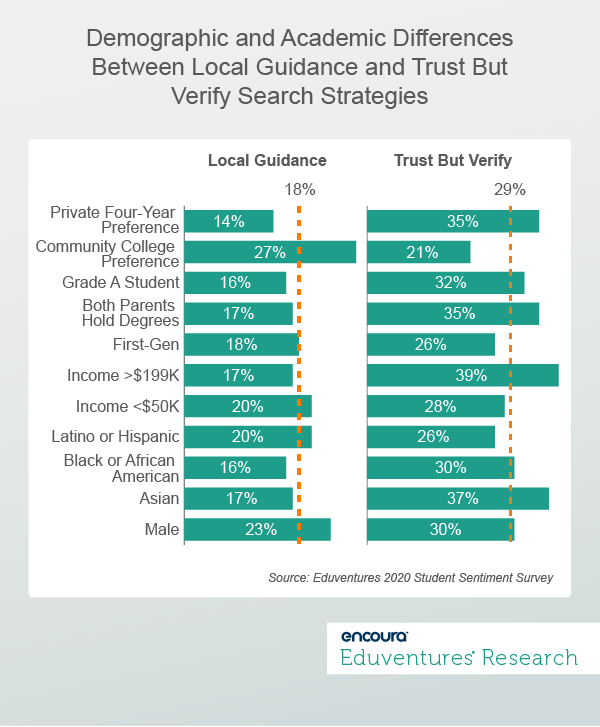The pandemic has forced institutions that recruit traditional college-bound students to abandon proven communication search strategies. For some, this provided a welcome opportunity to finally toss dated methods and try out new tactics. For others, this pivot was about bare bones survival, offering little time for reflection.
Now that we have entered a new recruitment cycle, uncertainties still linger. But so does the opportunity to reinvent, reinvest, and refine. Now is the time to innovate more thoughtfully and with purpose.
To help inform this process, Eduventures re-examined the Search Strategies college-bound high school students used in their college searches. and what can we learn from this?
Not All Searches Are Created Equal
COVID or no COVID, students differ in the ways they seek information about colleges. Unless your communications strategy takes this into account, you may not be reaching all the students you’d like to reach, and you may be missing opportunities to better optimize resources by creating large and expensive “one-size-fits-all” outreach campaigns.
Analysis of our 2020 Student Sentiment Survey™ uncovered five distinct undergraduate Search Strategies students use when they gather information about colleges.
Getting Started (24%)
Students who use this strategy, many of whom are early in their searches, are checking out all the basics like email, print, and websites, but not much else.
Active Explorer (11%)
Students who use this strategy, many of whom are early in their searches, are curious and active communicators, but may not know which information sources they should trust yet.
Local Guidance (18%)
Students who use this strategy seek guidance from people in their high schools and personal lives; when they do engage with colleges, personal contact is preferred.
Trust but Verify (29%)
Students who use this strategy consume the official story on your website and social media, but they double-check its veracity through rankings and guides.
Future Fit (18%)
Students who use this strategy see faculty as your key experts; they want to get to know students and administrators too.
These strategies describe approaches on a vast spectrum of engagement from less sophisticated (i.e., Getting Started, those who consume the key recruitment communication available with minimum effort) to more sophisticated (i.e., Future Fit, all of whom—100%—want to talk to faculty). But, how can institutions use this information to create better outreach strategies? The key to this lies in understanding the students who use these strategies and where they are in their college search journeys.
Want to Reach More Men? Think Locally!
For a better understanding of why students approach college search in different ways, let’s compare two of the strategies: Local Guidance and Trust but Verify. Both are proportionally more often used by students in upper class years (29% of students using each are high school seniors, compared to 24% in the total sample), suggesting many of these students are in more advanced stages of college search. Yet, they couldn’t be more different in their approaches.
Students who use the Local Guidance strategy trust the information they receive from individuals in their high school orbits, like high school counselors, family and friends, and high school teachers. When they interact with admissions, they are more likely to pick up their phones to call or text compared to other students.
In contrast, students who use the Trust but Verify strategy are the least eager group to talk with admissions. Like most students, they are open to receiving emails, but are the most likely to ask questions on social media. They read information on institutional websites, but double-check it against information from current students, alumni, rankings, and online guides.
Figure 1 below shows key demographics for the students within these two Search Strategies that illustrate the differences in search behavior.

The dotted orange lines in the charts show the overall proportion of students in the sample who used that particular strategy. The teal bars show the proportion of students within each demographic segment who used that strategy. For instance, 18% of students in our sample used the Local Guidance strategy. When we look at male students, however, we saw that 23% used this strategy.
It is important to remember that students from all walks of life search for colleges using either the Local Guidance or Trust but Verify strategies. That is true for all of the Search Strategies. Certain strategies, however, are overrepresented within certain student segments. Local Guidance, for example, is more likely to be used by male students, students who prefer community colleges, those who are lower income, or by Hispanic and Latinx students. Perhaps these students trust the information given by high school constituents the most because they are not familiar with other sources.
The Trust but Verify strategy, on the other hand, is significantly more often seen among higher income students, Asian students, those who prefer a private institution, and students with two college-educated parents. It is possible that these students, whose parents once navigated the college search process themselves, are more wary about institutional recruitment efforts or experience more familial pressure to attend a selective institution.
This indicates that institutions hoping to recruit more male students might increase their outreach successes by forging close relationships with local high schools and guidance counselors. In contrast, the Trust but Verify strategy is more prevalent among students who are likely full-pay but may be less easily convinced of the institutional value proposition. Schools looking to attract Trust but Verify searchers will have to work harder to reach them.
The Bottom Line
Pre-COVID-19, admissions offices spent time carefully crafting a message of value and fit to prospective students. Sometimes, these messages were personalized and differentiated. But too often they were blasted along the same communication channels with the hope that the target recipients would take note.
What better time to change this practice than now?
Our research suggests that students differ in key ways based on their search behaviors, the information sources they trust, and the way they want admissions officers to communicate with them. Tailoring not only messaging but also channels to specific student segments can increase your chances of reaching the right audience, while potentially reducing costs by eliminating large, but less effective, broadcast campaigns.
Never Miss Your Wake-Up Call
Learn more about our team of expert research analysts here.
Eduventures Senior Analyst at ACT | NRCCUA
Contact
October 1, 2020 at 2PM ET/1PM CT 2pm EST
This year, a record incoming class will forge its path at Florida Atlantic University. Building on multiple years of success, the team at FAU continues to evolve its search strategies with data, research and agile execution. Join Maura Flaschner, Executive Director of Undergrad Admissions and Joel Vander Horst, Director of Admissions and Enrollment as they discuss how FAU was able to mature its enrollment practices and partner with ACT | NRCCUA to make the class by communicating student-centric pathways via the most relevant channels.






